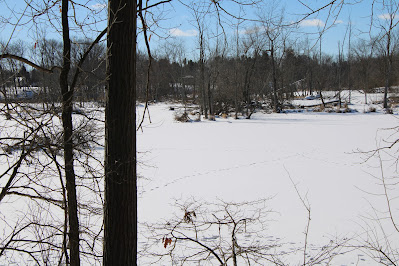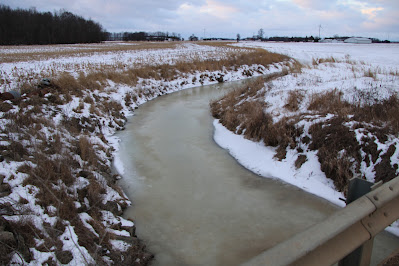The mid-morning skies are mostly sunny with temperatures in the high 20’s ,as I trudge through 5-6 inch snow cover while exploring the grounds of the Runway Disc golf course, on the east side of Alma, next to the Pine River. Heading east toward the river, I notices lots of fresh deer tracts. Less noticeable are tracks of a Short-tail Shrew. These 4-inch, mole-like mammals (stock photo) are active day and night, making “runs” above ground or tunnels underground. Their diet includes insects, worms, birds, roots, nuts and fruits. To maintain their body temperature in the winter, they eat about 40% more food than at other times of the year. Also, less noticeable are tracks of a Deer Mouse. These 3-inch rodents (stock photo) are nocturnal, and most active at twilight. They spend most of their time under snow in the winter, burrowing tunnels to travel between their nests and food sources. These tunnels help protect them from predators like foxes and birds. They eat a wide variety of foods, including seeds, nuts, fruits, and insects. Nearby, I’m surprised to see a small Juniper tree recently fed on by several deer. Usually its pungent fragrance, sharp prickly needles and bitter-tasting bark will keep them away. However, a shortage of regular food sources must be forcing them to feed on this tree. Further exploring the area, I come upon an open field with lots of dried seedheads of Spotted Knapweed, reminding me of what a large patch of these invasive plants look like when blooming (stock photo). After hiking under some tall White Pine trees while a Cardinal was singing, I come to the edge of the Pine River where lots of tracks crisscross the ice-covered water. Turning around and heading back to the car, I look afar at a White-tail deer staring back at me. Suddenly, it takes off, leaping over the snow-covered fairway. Being curious about the length of its leap, I find its tracks in the snow and estimate the distance at about 10 ft. Near the car, I spot a Wild Rose shrub with thorny branches, red hips and a strange looking hairy growth called a Mossy Rose Gall. While mostly harmless to the plant, these galls are an intricate ecosystem, created to house and sustain a complex world largely unnoticed. The life cycle involves a tiny wasp laying eggs on the plant, the eggs hatching and the feeding larvae triggering the plant to grow larger cells, eventually forming the mossy gall. The gall provides some protection from adverse weather, predators and parasites. After the larvae pupate in the gall, adult wasps emerge in the spring or summer.
In the season of snow
When leaves disappear
You dart over branches
You display no fear
You scamper so fast
From tree to tree
You chatter above
You fascinate me
Creature of nature
In light of these days
Squirrel of the winter
I admire your ways
D. DeGraaf



